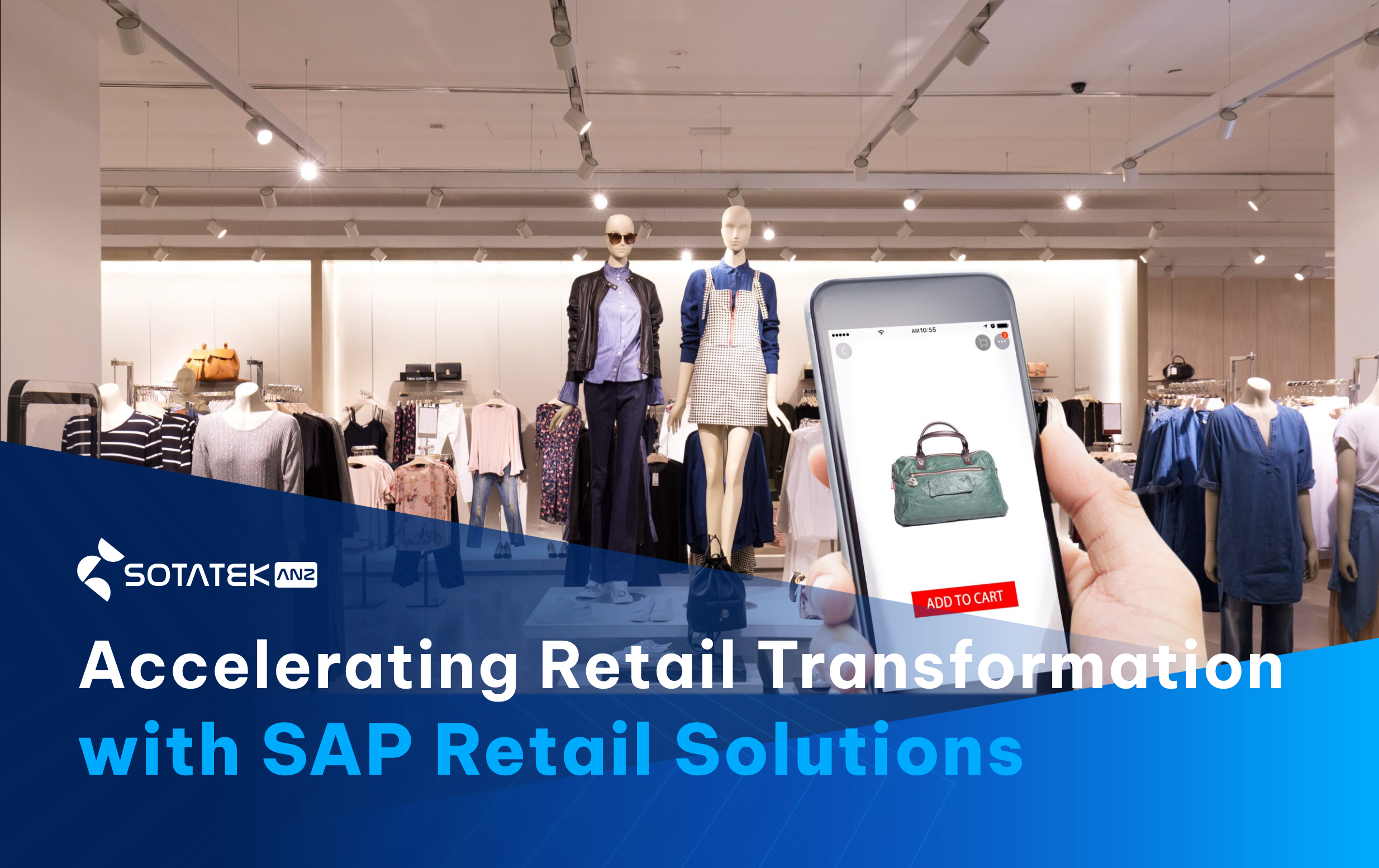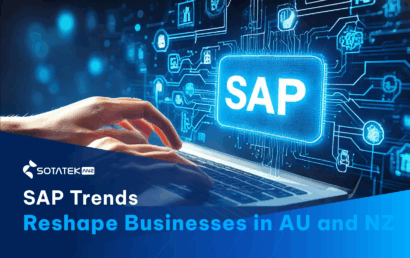Introduction
Retail today moves fast. Customers expect accurate stock information, smooth checkout experiences, and consistent service across every touchpoint. Many retailers, however, still rely on disconnected systems that cannot support real time operations or data driven decisions.
SAP Retail changes that by offering a unified platform where merchandising, supply chain, store operations, and customer experience work together. This integrated approach is especially valuable for businesses in Australia and New Zealand. The region faces long supply chains, high logistics costs, and constant shifts between online and in store demand. Retailers need technology that gives them clarity and control, not more complexity.
SotaTek ANZ supports companies across the region in adopting SAP Retail with a strong focus on performance, scalability, and industry best practices. With the right implementation, SAP Retail becomes a foundation that helps businesses plan smarter, move faster, and deliver a better shopping experience.
What is SAP Retail and How does it work?
SAP Retail is an industry focused solution within the SAP ecosystem that manages the full retail lifecycle. It combines product data, pricing, supply chain processes, inventory, and sales operations into one consistent system.
To understand how it works, we can look at its core components.

SAP Retail Core Modules
Centralized Article Master
SAP Retail maintains a detailed article master that stores every product attribute from brand and size to color and season. Once an item is created, all related processes use the same data. When a price or promotion changes, every channel receives the update instantly. This ensures accuracy and reduces manual work.
Integrated Supply Chain and Procurement
The solution connects store sales with distribution centers and suppliers. Purchase orders, replenishment recommendations, goods receipts, and vendor communication all run through the same platform. Because supply chain data aligns with real demand, retailers avoid overstocking and reduce the risk of empty shelves.
Demand Forecasting and Replenishment
SAP Retail uses historical sales, trends, and planned promotions to predict demand. These forecasts help businesses calculate the right stock quantities for each store. The system then generates replenishment proposals that keep inventory healthy and balanced.
Assortment and Pricing Management
Retailers can build store specific assortments, manage lifecycle phases, and create pricing strategies for different channels. This flexibility is important for ANZ markets where customer preferences differ widely between regions. The platform helps retailers maintain consistency while still tailoring offers to local needs.
Real Time Visibility Across Channels
With all processes linked, retailers get a real time view of stock levels, sales performance, and operational bottlenecks. This visibility supports faster decision making and ensures that customers receive a reliable shopping experience whether they are in store or online.
Key Modules in SAP Retail Solutions
SAP Retail brings together several essential modules that help retailers manage products, pricing, store operations and customer engagement in one unified environment. These are the modules most commonly used in real implementations.
Master Data and Article Management
This module stores all key information about products, stores and suppliers. Once a change is made, every connected channel receives the update immediately. Reliable master data is crucial for retailers in Australia and New Zealand who operate across large geographical areas and need consistent product information everywhere.
Merchandise Planning and Assortment
Retailers use this module to plan seasonal ranges, build assortments and tailor product selections for specific regions or store clusters. It helps ensure the right products reach the right locations, which is especially important in the diverse ANZ market.
Pricing, Promotion and Markdown Management
SAP Retail centralises pricing and enables retailers to schedule promotions and markdowns with ease. Updates sync directly with POS and eCommerce, ensuring customers always see accurate prices. This reduces manual work and helps businesses execute campaigns faster.
Procurement, Inventory and Replenishment
This module connects buying decisions with real time demand insights. It automates purchase orders, manages stock levels and calculates replenishment needs. For ANZ retailers dealing with long supply routes, this reduces stockouts and improves overall supply chain efficiency.
Store Operations and POS Integration
Daily store tasks such as stock counting, goods receipts and price changes run through this module. POS integration provides instant visibility into sales and returns. With real time data flowing back to head office, retailers can make quick adjustments and maintain accurate inventory.
Customer Activity Repository and CRM
The CRM layer gathers customer and transaction data from both in store and online channels. It supports loyalty programs, segmentation and personalized offers. With shoppers in Australia and New Zealand expecting more tailored experiences, this module helps retailers build stronger and more data driven customer relationships.

Key Modules in SAP Retail Solutions
How does SAP transform the Modern Retail Industry?
Modern retail is under pressure from many sides. Customers move between store, web, app and marketplace in the same journey. They expect accurate stock information, fast delivery options and consistent prices wherever they shop. At the same time, retailers must control costs, manage complex supply chains and react quickly to demand shifts.
SAP transforms this environment by turning retail into a connected, data driven business. SAP S/4HANA Retail for merchandise management links finance, supply chain, sales and distribution on a single digital core, so information moves smoothly across the value chain rather than staying in silos.
Several capabilities stand out:
- Unified data and processes across channels
SAP Retail solutions connect merchandising, inventory, pricing, promotions, CRM, eCommerce and POS on one data model. Product, price and stock are stored once, then reused everywhere. This reduces mismatches between systems and gives every team the same numbers when they plan, buy and sell. - Real time inventory and faster order fulfilment
With item and location level stock in SAP S/4HANA and SAP Customer Activity Repository, retailers can see what is available by channel and reserve inventory for online or in store orders in real time. This supports click and collect, ship from store and same day delivery without relying on manual checks or overnight batch jobs. - Better decisions through analytics and AI
SAP Retail uses memory processing in SAP HANA and analytics tools to give planners and executives up to date insights into sales, margins, promotion performance and forecast accuracy. SAP describes this as a move toward an intelligent enterprise where retailers use data to identify growth opportunities, optimise markdowns and improve the customer experience - Omnichannel experiences with consistent journeys
SAP highlights that retail innovation now depends on agile, experience led engagement. By connecting POS, eCommerce and customer data, retailers can create smoother journeys from first search to final checkout and returns. SAP Omnichannel solutions help unify POS transactions and inventory across systems so customers receive reliable promises, fewer cancellations and clearer communication. - A cloud ready platform for ongoing innovation
SAP is expanding SAP S/4HANA Cloud, public edition for retail and fashion into more Asia Pacific markets, including Australia. This gives retailers access to regular innovation cycles, embedded best practices and a more flexible way to scale without heavy infrastructure investments.
In simple terms, SAP transforms retail by turning isolated systems into one coherent platform. Planning, buying, stocking and selling no longer happen in separate worlds. Data flows in real time, which lets teams respond faster to the market and create experiences that feel consistent from channel to channel.
Related: Top 5 Benefits of SAP Development for Businesses in Australia and New Zealand
SAP Retail Implementation Guide for Australia and New Zealand
Implementing SAP Retail in Australia and New Zealand follows the same core principles as in other regions, but the geography, logistics costs and market size make careful planning even more important. Below is a practical, vendor neutral guide built from SAP recommendations, SAP community case studies and common project patterns.
Start with a clear retail and S/4HANA roadmap
Many organisations in ANZ are already analysing their journey to SAP S/4HANA and industry specific solutions such as SAP S/4HANA Retail. Studies of S/4HANA adoption in the region show that companies need a realistic view of timelines, migration waves and resource availability.
For retailers, this usually means:
- Identifying which processes must move first, for example merchandise management and inventory visibility
- Deciding between SAP S/4HANA on premise, private cloud or public cloud editions that now include retail and fashion features for countries such as Australia
- Mapping how SAP Retail modules will support future growth in stores, online channels and marketplaces
Assess current systems, data and retail processes
SAP and its partners consistently stress that master data quality is a critical success factor when moving to SAP Retail. Retail specific guidance on S/4HANA projects highlights the importance of understanding existing article data, store hierarchies, supplier records and stock information before migration.
For ANZ retailers, a structured assessment should:
- Catalogue all current retail systems such as POS, warehouse, eCommerce and loyalty platforms
- Evaluate data quality for products, customers and inventory, especially where multiple systems hold overlapping records
- Identify regional rules, tax conditions and supply chain constraints that must be reflected in SAP configuration
Design an integrated process landscape
SAP S/4HANA Retail for merchandise management is designed to cover all processes relevant to retail and to integrate with finance, sales and supply chain.
At design stage, project teams typically:
- Define how merchandise planning, procurement, pricing and promotions will work end to end
- Align store operations and POS integration so sales and stock figures post back into S/4HANA without manual steps
- Plan how customer data will flow into SAP Customer Activity Repository and CRM tools to support loyalty and omnichannel journeys
For Australian and New Zealand businesses operating across wide distances, it is also important to model distribution networks and transport lead times so replenishment logic matches actual logistics conditions.
Plan data migration and cutover carefully
SAP community case studies on retail migrations to S/4HANA underline the need for clean, well governed data migration. They describe master data as the backbone of SAP Retail and highlight that poor migration can limit the value of the solution.
Key points for ANZ retailers include:
- Running multiple test cycles for article, vendor, customer and inventory migration
- Validating that store and distribution centre stock values reconcile between legacy systems and SAP
- Aligning cutover windows with trading calendars to avoid large changes during peak seasons such as Christmas or Boxing Day
Use phased rollouts and pilot stores
While SAP does not mandate a specific rollout model, many retail case studies describe phased deployments and pilot waves. This lets retailers prove the solution in a limited group of stores, refine processes and then expand to the wider network with fewer surprises.
For Australia and New Zealand region, pilots can be planned across a mix of metro and regional locations to test:
- How well replenishment and allocation settings work with different demand patterns
- How store teams adapt to new Fiori based applications for store operations
- How omnichannel processes like click and collect perform in practice
Partner with experienced SAP and retail specialists
SAP recommends that customers work with partners who understand both the technology and the specific industry. In ANZ there is a growing ecosystem of SAP partners that focus on retail and S/4HANA and provide support for regional requirements.
SotaTek ANZ positions itself as a global SAP development and consulting partner, with a dedicated Australia and New Zealand presence and experience in building SAP based solutions that unify data, inventory and pricing across channels, including SAP Retail implementations.
Working with such partners helps retailers:
- Tailor SAP Retail to their unique merchandising, pricing and logistics models
- Integrate SAP with existing POS, eCommerce and marketplace platforms
- Establish ongoing support and enhancement cycles rather than treating the project as a one time event
Conclusion
To conclude, SAP Retail helps businesses move from fragmented systems to a single, connected retail platform. By bringing product data, pricing, inventory and customer insights into one place, retailers gain real time visibility and smoother omnichannel operations. For companies in Australia and New Zealand, this level of control is essential in a market shaped by long supply chains and rapidly changing consumer expectations. With the right guidance, SAP Retail becomes a foundation for more efficient operations and stronger customer experiences.
SotaTek ANZ delivers end to end SAP services, including SAP S/4HANA development, SAP Retail configuration and custom SAP Fiori applications. With a team of SAP certified engineers and hands-on experience across the ANZ region, SotaTek ANZ helps retailers modernise systems, improve data accuracy and streamline daily operations. If you are planning your SAP Retail journey or need expert support, our team is ready to assist.
Let’s build your next retail milestone together.
Discover more about SotaTek ANZ on LinkedIn.







